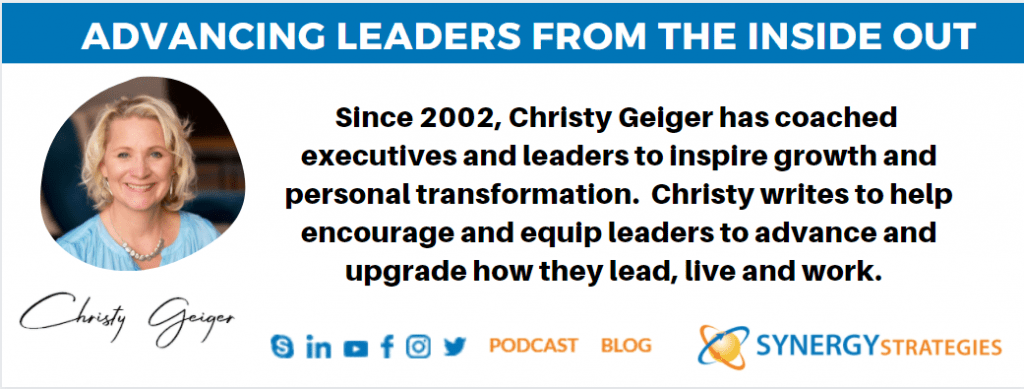Leadership can be intimidating. Among other reasons, there is the responsibility that comes with leadership that makes people nervous. They don’t want to be on the hook for the decision or do not feel they are qualified to direct the way. They dislike conflict, feel their plate is full with their tasks much less thinking about others, they feel tapped at their own bandwidth and “leadership” feels overextending. Therefore, many people do not see or identify themselves as leaders. They say, “I am not a leader.” While some leaders are obviously leaders due to their significant responsibility to be in charge of an organization or company, it is important to know all humans are “leaders” on some level.
Look at children, you see leaders even in kids. They have no title or position, yet leaders appear. Leaders are not always good. You see kids who are negative and “bad” influences, they are leaders as well. Leadership is not about a title, rather who you are, what you do and how you show up in the world. These are all related, but
#1) Lead Yourself. The first person you lead is yourself.
- Who you are has to do with your attributes and mindset. Choosing your mindset and character to be kind, loving, thoughtful, others-centric, having integrity, humbleness and honest vs. frustrated, angry, quick-tempered, short and erratic. How you are feeding your body, mind, and spirit? Are you acting with integrity and doing what you said you will do?
- What you do has to do with the decisions and actions you make each day to be your best self. Are you organized, planned and responsive? What is important that you do today for commitments you have made to yourself and the responsibilities you hold? Are you making processes or procrastinating? Are you being a lid for yourself or moving things forward?
- How you show up is about your impact on others because of who you are and what you do. We all have energy that we give out and impact others. It can be good, neutral or bad. Those with good impact make the world a better place and have an energy that is attractive. People desire to be around you because of who you are and how you inspire them to be better.
#2) Lead Those Around You (family, friends, peers, etc.)
- Who you are, attributes and mindset: How are you in relationships – loving, thoughtful and generous to others, or focused on yourself, your agenda and needs? Are you aware of how others are feeling? Do you notice others and are you present enough to be concerned, interested and attentive? Do you see others for their strengths or their weaknesses? Do you put the best construction on others or assume the worst? Do you see people and connections or do you pull back? While this can be more challenging for introverted people, the importance of who you are with others is critical to positive and lasting relationships.
- What you do, decisions and action: Are you responding to others needs and requests? Do you listen to their emails, voice mails, and texts? Do you communicate? Do you take action and follow through on things? This leadership is not about things you want to do, but things others need from you – and how you respond and interact with others is important.
- How you show up, impact: Reflecting on the impact you have on those around you – our family often gets our leftovers because we assume they will always be there. Paying attention to the impact you are having on others will help you discern and adjust the activity you are doing if you really care about connecting. Leading others isn’t about telling them what to do, rather leading others is about how you show up with others, how you are able to help move things to the next level for the benefit of those you have a relationship with, making your relationships strong and flourishing because of how YOU choose to lead in your relationships.
#3) Lead Those you are responsible for (team, reports, organization, people impacted by your actions)
- Who you are, attributes and mindset: Again, this is built on how you are leading yourself and in your general relationships, but often we think just about these “professional” relationships and we suddenly turn into superman professionally. Truth is, this is easy when the first two areas have been solidly laid. When you are lacking in the first two areas and suddenly try to be the “amazing leader” at work, it is often met with questions, skepticism, and judgment of your authenticity and honesty. For work, who you are is a continuation of the areas above, extending those characteristics to all relationships – even those that seem insignificant to your work and role. Think of someone you usually don’t see, consider lesser than or beneath you (your human – who is that person who you sneer about, annoys you or you avoid?) Use them as your challenge to up your game in WHO YOU ARE. See people with respect, understanding and positive regard. Every human has a story – try to see beyond hard shells or dirty clothes that mask the human heart.
- What you do, decisions and action: Your actions then are a reflection of the way you value and see people. In “role” leadership, we often get consumed with our responsibilities and forget about people. Each person on the team matters and taking time daily to ensure you are opening the doors, listening and responding to their needs and thoughts is setting your team up for success. Your team is not there to support you. You are there to support your team to do what you and the organization have asked them to do.
- How you show up, impact: Check in on the impact you are having. If you are doing well in who you are being and what you are doing, you will experience the impact on your organization. If you are falling short (which we as leaders usually will be) find where and make adjustments. It isn’t a failure, it is leadership. Your impact is a great measuring stick of how you are leading yourself, your personal relationships and your professional relationships. Positive impact has positive ripples and splashes of joy. Any other impact will show the flat or lacking energy. Look for it, understand it and make adjustments. You control your leadership and impact because it is cast from your energy, mindset, and activity.






